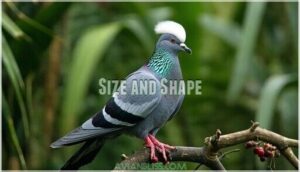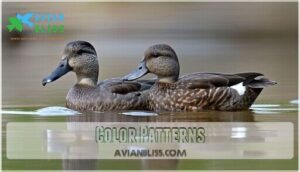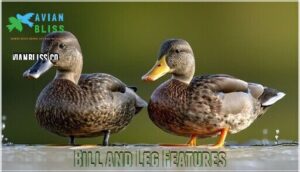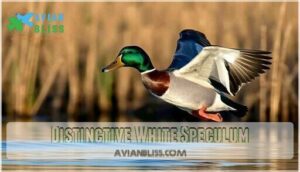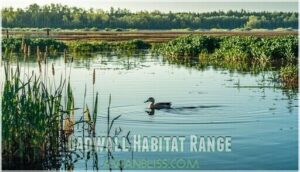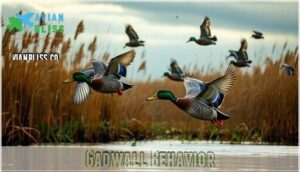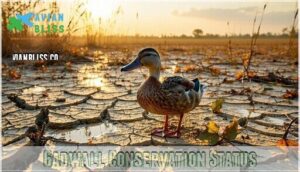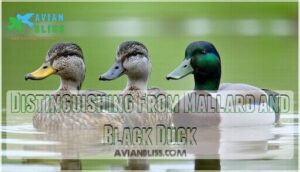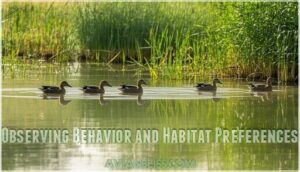This site is supported by our readers. We may earn a commission, at no cost to you, if you purchase through links.
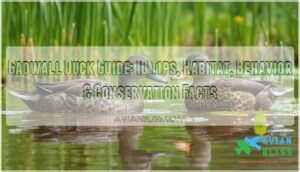
Males sport refined gray bodies with black rumps, while females display mottled brown feathers and orange bills with black markings.
These adaptable ducks thrive in shallow freshwater wetlands across North America, shifting their diet from aquatic plants to protein-rich invertebrates during breeding season.
Though habitat loss has reduced their breeding areas by 50% since 1950, gadwalls maintain stable populations through remarkable versatility in wetland environments.
Their precise migration patterns and sophisticated feeding techniques reveal surprising complexity beneath their understated appearance.
Table Of Contents
Key Takeaways
- You’ll identify gadwalls by their distinctive white wing patches – the only North American dabbling duck with this unique square speculum that’s visible during flight or swimming.
- You can find these adaptable ducks in shallow freshwater wetlands across North America, Europe, and Asia, where they prefer areas with abundant aquatic vegetation for feeding and nesting.
- You’ll notice their diet shifts seasonally from primarily aquatic plants during non-breeding periods to protein-rich invertebrates during breeding season, using specialized dabbling and surface-grazing techniques.
- You’ll be pleased to know that gadwall populations remain stable despite losing 50% of their breeding habitat since 1950, thanks to their remarkable adaptability and successful conservation efforts that’ve restored over 2 million acres of wetlands.
Gadwall Characteristics
When you spot a gadwall, you’ll notice it’s a medium-sized duck with understated elegance compared to flashier waterfowl species.
These ducks measure 18-23 inches long with distinctive features including a square head, thin bill, and the telltale white wing patch that sets them apart from other dabbling ducks.
Size and Shape
When you spot a gadwall, you’ll notice its medium sized duck proportions that fall between a crow and goose.
These ducks measure 18-23 inches in Body Length with a 33-inch Wing Span.
Key size features include:
- Square Head Shape with steep forehead
- Thin Bill Size compared to mallards
- Slender Neck Thickness and streamlined wings
- Bird measurements averaging 2-2.5 pounds
- Bird dimensions slightly smaller than mallards
Color Patterns
When you observe gadwall duck plumage, males display subtle gray feathers across their body with a distinctive black rump that contrasts sharply.
Females show mottled brown feathers throughout their plumage.
Both sexes feature the characteristic white speculum on their wings, making gadwall identification easier among duck species.
This bird color pattern creates an understated elegance compared to flashier waterfowl varieties.
Bill and Leg Features
You’ll notice the gadwall’s bill shape differs substantially from other duck species.
The thin, narrow bill helps distinguish gadwalls from mallards, which have broader beaks.
Male gadwalls sport all-black bills, while females display orange bills with black markings.
Their leg color stands out too – bright yellow feet and legs make identification easier.
This foot structure supports their dabbling feeding style perfectly.
Understanding key bird identification techniques is vital for distinguishing between similar species like the gadwall and mallard.
The ability to identify these characteristics is essential for bird enthusiasts.
Distinctive White Speculum
You’ll recognize the gadwall duck by its unique white speculum—a square patch on the trailing edge of each wing.
This distinctive white speculum sets gadwalls apart from all other North American dabbling duck species, making identification straightforward during flight or when swimming.
- The white speculum contrasts sharply with surrounding chestnut and black wing feathers
- Both male and female gadwalls display this white wing patch year-round
- The speculum becomes most visible when wings are extended during takeoff or landing
Gadwall Habitat Range
You’ll find gadwalls across North America’s four major flyways, with their highest concentrations in the Central and Mississippi corridors.
These adaptable ducks breed from the Great Lakes to Alberta and winter throughout the southern United States and into Mexico.
Breeding and Nesting Sites
Gadwall’s breeding habitat centers around shallow freshwater wetlands with abundant vegetation.
You’ll find their highest nesting densities on protected nesting islands, where up to 150 nests per acre create bustling island colonies.
These ducks choose nest locations in tall grasses near water, using available nesting materials like dried vegetation to construct ground nests during breeding season.
Wintering and Migration Habits
These ducks follow established flyway patterns across North America, traveling migration routes that span thousands of miles.
You’ll find them wintering in coastal Louisiana marshes, Texas wetlands, and California’s Central Valley.
Their flocking behavior creates groups under 100 birds at stopover sites, and duck migration timing peaks in late October, with migratory patterns showing remarkable consistency across decades.
The Gadwall’s migratory habits are influenced by their natural habitat needs and available food sources during different seasons.
Preferred Wetland Environments
You’ll discover that gadwalls thrive in diverse wetland habitats, from shallow freshwater marshes to brackish coastal areas.
Gadwalls flourish in wetlands ranging from freshwater marshes to coastal brackish waters, adapting beautifully to diverse aquatic environments.
These adaptable ducks master any wetland environment with remarkable ease and grace
These adaptable ducks prefer environments rich in aquatic vegetation for feeding and protection.
Key preferred wetland environments include:
- Freshwater Habitats – Prairie potholes, ponds, and lakes with abundant submerged plants
- Emergent Wetlands – Seasonal marshes with mix of open water and vegetation
- Marsh Conservation areas – Managed refuges maintaining high-quality water conditions for duck habitat
Understanding the importance of wetland conservation efforts is vital for preserving these habitats.
Geographic Distribution
You’ll find gadwalls across three continents with their circumpolar distribution spanning North America, Europe, and Asia.
Their breeding sites stretch from Canada’s Prairie Pothole Region to Alaska, while migration patterns follow all four North American flyway routes.
Wintering grounds extend from the southern United States through Mexico, with habitat range expanding globally as populations adapt to new wetland environments.
Gadwall Behavior
You’ll find gadwall behavior fascinating as these ducks combine predictable feeding patterns with surprisingly unpredictable flight habits.
They’re methodical foragers that specialize in aquatic vegetation but often frustrate hunters by circling just out of range before departing entirely, exhibiting unpredictable flight habits.
Feeding and Foraging Habits
Over 50% of their diet consists of aquatic plants during non-breeding seasons.
You’ll spot them targeting pondweeds, duckweeds, and submerged vegetation in shallow waters.
Their diet composition shifts seasonally—spring brings increased invertebrates and aquatic insects for protein during breeding.
These herbivorous ducks use specialized foraging strategies, selecting food sources within 30 meters of shoreline vegetation for maximum feeding success.
Understanding proper duck food sources, such as those found at duck food sources, is essential for maintaining a healthy duck population.
Dabbling and Grazing Techniques
You’ll watch gadwalls employ two primary dabbling methods when they feed.
These dabbling ducks tip forward to reach submerged plants below the surface, keeping their tails up while their heads disappear underwater.
They also graze directly at the water’s surface, collecting floating vegetation and invertebrates.
Their herbivorous nature drives them to target pondweed, naiad, and widgeon grass through these efficient water foraging techniques.
Understanding proper duck feeding tips is essential for their overall health and well-being.
Social Interactions and Bonding
You’ll notice gadwalls aren’t loners like some ducks.
These birds form loose flocks outside breeding season, creating group behavior patterns that help with survival.
During mate selection, pair bonding occurs through courtship displays and social learning within the flock.
Duck behavior shows monogamy during breeding, with bird social interactions strengthening their duck breeding success through established bird mating habits.
Migration and Flight Patterns
Gadwall migration follows North American flyways with remarkable precision.
You’ll spot these birds during fall migration from August through November, traveling at moderate altitudes in loose flocking behavior.
They use specific stopover sites along their flight routes, timing their journeys with seasonal changes.
Migration distribution spans from northern breeding grounds to southern wintering areas across multiple flyways.
Gadwall Conservation Status
You’ll find that gadwall populations face several conservation challenges, though they’re currently stable across most of their range.
Habitat loss from agricultural development and drought conditions in key breeding areas remain the primary concerns for wildlife managers monitoring these understated waterfowl.
Threats to Habitat and Population
Multiple threats endanger gadwall populations across North America.
Habitat Loss from agricultural development has eliminated 50% of suitable breeding areas since 1950.
Climate Change shifts breeding ranges northward while disrupting nesting cycles.
Pollution Effects include pesticide bioaccumulation and toxic runoff creating harmful algal blooms.
Human Impact through urban development fragments critical nesting sites, accelerating Population Decline in key regions.
Conservation efforts must address the bird conservation status to mitigate these threats effectively, considering Habitat Loss and Climate Change.
Effects of Drought and Water Diversion
Climate change strikes at the heart of gadwall survival through persistent drought impacts and water diversion projects.
When wetlands shrink, these waterfowl species face severe habitat loss and ecosystem disruption.
Water scarcity forces ducks to compete for remaining resources, while wetland degradation reduces food availability.
You’ll notice fewer gadwall populations where water diversion removes critical breeding grounds from wetland birds seeking suitable nesting areas.
Conservation Efforts and Management
Active habitat restoration projects substantially boost gadwall populations through strategic wetland management.
Wildlife refuges and conservation partners have restored over 2 million acres since 2010, increasing breeding densities by 25%.
These conservation strategies include predator control, invasive species removal, and artificial nesting structures, improving nest success rates by 18%.
State and National Protection Status
You’ll find gadwalls aren’t on the Endangered List, as their IUCN Status remains "Least Concern" globally.
However, duck conservation efforts still matter since habitat preservation challenges affect their populations.
Protected Areas like Wildlife Refuge systems provide essential support through Conservation Laws that maintain wetland ecosystems for successful bird conservation outcomes.
Gadwall Identification Tips
You’ll find gadwall identification challenging at first glance since they lack the flashy patterns of other ducks.
However, their subtle gray plumage and distinctive white wing patches make them easy to spot once you know what to look for, which can make identification easier.
Distinguishing From Mallard and Black Duck
You’ll spot a Gadwall by its white wing speculum—the only North American puddle duck with this feature.
The Mallard shows blue wing patches with white borders, while the Black Duck displays purple speculum without white edges.
Gadwall males have gray bills and slender heads, contrasting with Mallard’s yellow beak and Black Duck’s olive bill.
Understanding the duck species differences is essential for accurate identification of these duck species.
Recognizing Gender and Age Differences
Male gadwalls sport subtle gray bodies with black rears and chestnut wing patches, while female markings include mottled brown plumage with orange-edged bills.
Juvenile traits resemble hen gadwall patterns until their first molt.
Drake gadwall yellow legs contrast with females’ duller coloration, making gender identification straightforward during breeding season, with female markings being a key identifier.
Identifying Key Physical Features
Look for the gadwall’s thin bill shape compared to broader mallard bills.
Notice the drake gadwall’s intricate gray feather patterns and black rump, while hen gadwall displays mottled brown plumage.
Head color appears grayish-brown on males, buffy-tan on females.
The distinctive white wing speculum serves as your best identification marker during flight.
Body size falls between mallards and teals, creating a medium-sized duck profile for reliable bird physical characteristics assessment.
Understanding bird identification techniques is essential for distinguishing between similar species, and checking out bird identification can be very helpful for reliable bird and physical characteristics assessment.
Observing Behavior and Habitat Preferences
Most gadwalls prefer shallow freshwater wetlands with abundant vegetation, making habitat selection predictable for bird watching enthusiasts.
You’ll notice their foraging strategies focus on dabbling and grazing rather than diving, while their social behavior includes following other waterfowl to prime feeding spots.
Their migration patterns and wetland ecology preferences help identify these understated ducks.
Frequently Asked Questions (FAQs)
Where do gadwall birds live?
You’ll find gadwall birds across North America, Europe, and Asia, preferring shallow freshwater wetlands, marshes, ponds, and lakes with abundant vegetation for feeding and nesting.
What does a gadwall look like?
You’ll recognize gadwalls by their medium size with distinctive gray-brown plumage, square white wing patches visible in flight, and males displaying subtle gray patterns with black rears.
What does a gadwall call?
Actions speak louder than words, and you’ll hear gadwall calls are remarkably quieter than other ducks.
Males produce a distinctive "mep" grunt sound, while females make higher-pitched quacks compared to mallards.
Where is the gadwall most common?
You’ll find gadwall most common in North America’s Central and Mississippi flyways, especially west of the Mississippi River.
They’re widespread across the Prairie Pothole Region and western states during breeding season.
How old is gadwall?
Using your smartphone to decode this mystery won’t help—you’d need a time machine instead. Scientists can’t determine the exact age of gadwall species from available research data.
Is a gadwall a diurnal duck?
Yes, you’ll find gadwalls are primarily diurnal, meaning they’re most active during daylight hours.
They feed, socialize, and move between wetlands during the day, though they may also forage at dawn and dusk.
Is Gadwall good eating?
Like a hidden gem in the duck world, you’ll find gadwall offers excellent table fare.
Their diet of aquatic vegetation creates mild, flavorful meat that’s less gamey than mallards, making them prized by hunters who appreciate quality over flashy appearance.
How rare are Gadwall ducks?
Gadwall ducks aren’t rare at all – you’ll find them across North America’s wetlands quite commonly.
Their populations have actually grown substantially, making them one of the more abundant dabbling duck species you can spot, and this growth is a key factor in their widespread presence.
What is another name for a Gadwall?
You’ll hear seasoned hunters call them "gray ducks" or simply "grays," though these waterfowl aren’t officially known by any other common name than Gadwall.
Where are gadwalls found?
You’ll find these versatile ducks across North America, Europe, and Asia, with North American populations breeding from the Great Lakes to Alberta and wintering throughout the United States and Mexico.
Conclusion
Decades of research confirm that gadwall populations remain remarkably stable despite significant habitat pressures.
You’ve now learned to identify this understated duck by its white wing patches, understand its wetland preferences, and recognize its feeding behaviors.
Armed with these identification tips, you can confidently spot gadwall ducks during your next birding adventure.
Their adaptability serves as a conservation success story, proving that thoughtful management protects waterfowl species effectively.
- https://animaldiversity.org/accounts/Anas_strepera/
- https://bioone.org/journals/wildlife-biology/volume-2020/issue-2/wlb.00668/Long-term-changes-in-the-autumn-migration-phenology-of-dabbling/10.2981/wlb.00668.full
- https://50ducks.com/data-center/gadwall-2/
- https://www.audubon.org/field-guide/bird/gadwall
- https://www.ducks.org/hunting/waterfowl-id/gadwall

